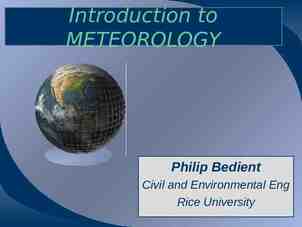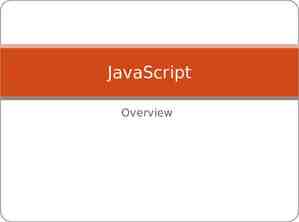Airspace
42 Slides239.10 KB
Airspace
Classifications Can either be controlled or uncontrolled Controlled: ATC Services MAY be provided Class A Class B Class C Class D Class E Uncontrolled: No ATC Services Class G 2015 Coast Flight Training. All Rights Reserved.
Why Classify Airspace with Codes? Each type of airspace has different requirements: ATC Communication Transponder Cloud Clearances Other Legal Requirements 2015 Coast Flight Training. All Rights Reserved.
Class G Airspace Think: Go for it! No requirements to communicate with ATC Continually decreasing Exists from ground to: Mostly 1200 feet AGL Sometimes 700 feet AGL Rarely 14,500 feet AGL Most uncontrolled airports are Class G airspace as well: Oceanside, Fallbrook, French Valley, Hemet 2015 Coast Flight Training. All Rights Reserved.
Class G Airspace – Cloud Clearances 91.155 Depends on Day or Night and Altitude: 1200 Feet or less above surface Day: 1 sm, Clear of Clouds Night: 3 sm, 1000 above, 500 below, 2000 horizontally More than 1200 feet above surface, less than 10,000 MSL Day: 1 sm, 1000 above, 500 below, 2000 horizontally Night: 3 sm, 1000 above, 500 below, 2000 horizontally More than 1200 feet above surface, more than 10,000 MSL 5 sm, 1000 above, 1000 below, 1 mile horizontally 2015 Coast Flight Training. All Rights Reserved.
Class E Airspace Think: Everywhere No requirements to communicate with ATC Laterally abuts all other types of airspace Also certain Airports may be in Class E airspace: Cochran Regional (Palm Springs Area) 2015 Coast Flight Training. All Rights Reserved.
Class E Airspace – Cloud Clearances 91.155 Depends only upon altitude: Less than 10,000 MSL: 3 sm, 1000 above, 500 below, 2000 horizontally More than 10,000 MSL: 5 sm, 1000 above, 1000 below, 1 mile horizontally 2015 Coast Flight Training. All Rights Reserved.
Class D Airspace Think: Dialogue Must communicate with ATC before entry Only an acknowledgement of Call-sign is required What does that acknowledgement sound like? Normally a smaller airport with a Control Tower Examples: Montgomery Field, Gillespie Field, Ramona 2015 Coast Flight Training. All Rights Reserved.
Class D Airspace Tower Closures: If the Tower closes, the airspace reverts to a Class G or Class E Check A/FD for information on Tower closures 2015 Coast Flight Training. All Rights Reserved.
Class D Airspace – Cloud Clearances 91.155 Always 3 sm, 1000 above, 500 below, 2000 horizontally 2015 Coast Flight Training. All Rights Reserved.
Class C Airspace Think: Congested Must have a Transponder Must communicate with ATC before entry Only an acknowledgement of Call-sign is required What does that acknowledgement sound like? Normally an airport with a Control Tower Examples: John Wayne, Ontario, Burbank 2015 Coast Flight Training. All Rights Reserved.
Class C Airspace – Cloud Clearances 91.155 Always 3 sm, 1000 above, 500 below, 2000 horizontally 2015 Coast Flight Training. All Rights Reserved.
Class B Airspace Think: Busy Must have a Transponder Must receive a clearance from ATC before entry “Cleared into the Bravo” What does that sound like? Normally a large international airport No student pilots Examples: San Diego, LAX, JFK, MIA 2015 Coast Flight Training. All Rights Reserved.
Class B Airspace – Cloud Clearances 91.155 Always 3 sm, Clear of Clouds 2015 Coast Flight Training. All Rights Reserved.
Class A Airspace Think: Atitude 18,000 Feet throughout the US Must be on an IFR flight plan No airport associated with it No cloud clearances 2015 Coast Flight Training. All Rights Reserved.
Airspace (Legalities)
Class G Airspace – FAR 91.126 Must turn to the left (pattern) unless published otherwise Applies only when approaching Must have communication with a control tower if one exists (normally no tower) 2015 Coast Flight Training. All Rights Reserved.
Class E Airspace – FAR 91.127 Must follow all of 91.126 Must also follow pattern as published on departure Must communicate with a tower prior to 4 miles out Normally no tower If radio fails, follow light gun signals (we’ll go over soon) 2015 Coast Flight Training. All Rights Reserved.
Class D Airspace – FAR 91.129 Must follow all of 91.126 & 127 Establish communication prior to entering airspace Satellite Airport: Contact as soon as practical Taxi Clearances 2015 Coast Flight Training. All Rights Reserved.
Class C Airspace – FAR 91.130 Follow 91.129 Satellite Airport: Must follow arrival and departure patterns Equipment Requirements: 91.215 - Transponder 2015 Coast Flight Training. All Rights Reserved.
Transponder Requirements – FAR 91.215 Class A Class B Class C 30 NM veil from surface to 10,000 feet MSL Above B or C to 10,000 feet MSL Above 10,000 feet MSL, if above 2,500 AGL 2015 Coast Flight Training. All Rights Reserved.
Class B Airspace – FAR 91.131 Follow 91.129 Clearance required Pilot Requirements: Private Pilot Student Pilot with Endorsements Must have Radio and Transponder 2015 Coast Flight Training. All Rights Reserved.
Other & Special Use Airspace
Federal Airways Often Called Victor Airways A Highway in the Sky Based upon a route from one Navaid to another 2015 Coast Flight Training. All Rights Reserved.
Special VFR Weather below VFR minimums – What to do? Special VFR brings Cloud Clearances to 1sm and Clear of Clouds Where? Some Bravo Charlie Delta Class E surface Areas 2015 Coast Flight Training. All Rights Reserved.
Special VFR – 91.157 Only below 10,000 feet MSL Must have clearance from ATC, remain C.O.C. 2015 Coast Flight Training. All Rights Reserved.
Special Use Airspace Airspace that is not classified under A, B, C, D, E, or G Controlled Firing Area Restricted Area Alert Area Prohibited Area Warning Area Military Operations Area 2015 Coast Flight Training. All Rights Reserved.
Alert Area Used to inform pilots of unusual types of aerial activities Responsibility for collision avoidance rests with all pilots 2015 Coast Flight Training. All Rights Reserved.
Military Operations Area A block of airspace in which military training or other military maneuvers are conducted Have specific floors and ceilings Where to find Contact FSS if in doubt Sua.faa.gov 2015 Coast Flight Training. All Rights Reserved.
Warning Area Activity that may be hazardous to nonparticipating aircraft Usually offshore 2015 Coast Flight Training. All Rights Reserved.
Restricted Area – 91.133 Often invisible hazards to aircraft such as artillery firing, aerial gunnery, or guided missiles Permission to fly through may be granted by controlling agency Where to Find Contact FSS Sua.faa.gov 2015 Coast Flight Training. All Rights Reserved.
Prohibited Area – 91.133 Established for security or other reasons for the nations welfare Flight is Prohibited at ALL times Permission to fly through may be granted by controlling agency Where to Find Contact FSS Sua.faa.gov 2015 Coast Flight Training. All Rights Reserved.
Controlled Firing Area Activities are discontinued when spotter aircraft, radar or ground lookouts observe an aircraft approaching the location Never depicted on an aeronautical chart As such, you may never know you flew through one 2015 Coast Flight Training. All Rights Reserved.
Can I Fly Into It? - Socrative Controlled Firing Area? Restricted Area? Alert Area? Prohibited Area? Warning Area? MOA? 2015 Coast Flight Training. All Rights Reserved.
National Security Area Where national security may be affected Not required, but probably a good idea 2015 Coast Flight Training. All Rights Reserved.
Military Training Routes Low-Level, High-speed military training flights Although you are not restricted from MTRs: Cross them directly perpendicular! Check with FSS 2015 Coast Flight Training. All Rights Reserved.
Temporary Flight Restriction – 91.137 Imposed by the FAA to protect persons or property on the surface from a specific hazard or situation Released by NOTAM at least 24 hours in advance TFR.FAA.GOV Common types: Presidential (91.141) VIP Firefighting Operations Sporting Events 2015 Coast Flight Training. All Rights Reserved.
Terminal Radar Service Area Some airports have the same services as a Charlie or Bravo Voluntary program 2015 Coast Flight Training. All Rights Reserved.
ADIZ Air Defense Identification Zone Established along our borders to identify if you’re an American aircraft or not If you cross one, you must be on a specialized flight plan - DVFR 2015 Coast Flight Training. All Rights Reserved.
Washington D.C. SFRA Special Training to fly in the D.C. Area, within 60 NM of the White House and Capitol Building Flight Restricted Zone over these buildings 2015 Coast Flight Training. All Rights Reserved.
Intercept Procedures Always a possibility to be intercepted What to do: Rock wings Contact on 121.5 (Guard) Comply Land if directed to do so Turn off engine Do not get out of airplane 2015 Coast Flight Training. All Rights Reserved.
References FAR/AIM Jeppesen Private Pilot Guided Flight Manual FAA.Gov Aeronautical Charts 2015 Coast Flight Training. All Rights Reserved.















































